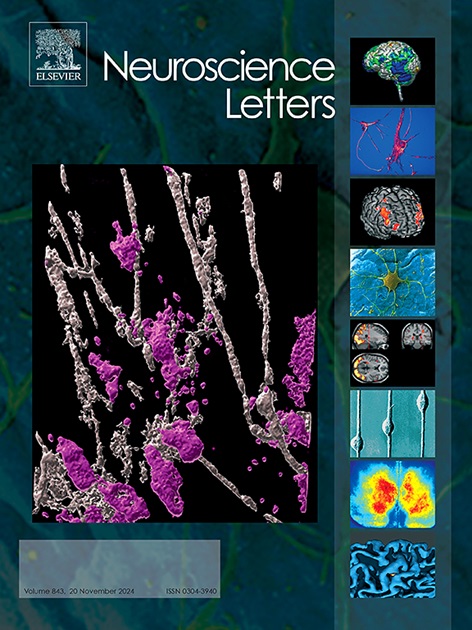Synergistic anxiolytic-like effect of CPPG and harmaline in non-stressed and acute restraint stress (ARS) mice
IF 2
4区 医学
Q3 NEUROSCIENCES
引用次数: 0
Abstract
Many studies revealed the role of metabotropic glutamate receptors (mGluRs) and harmaline in the modulation of anxiety-related behaviors. This study aimed to determine a possible interaction between harmaline and group III mGluR on the modulation of anxiety-correlated behaviors. The left lateral ventricle of male mice was unilaterally cannulated. Acute restraint stress (ARS) was induced by movement restraint for 4 h. Anxiety-like behaviors were measured using an elevated plus maze. The results showed that induction of ARS during 4 h reduced the percentage of time spent in open arms (%OAT) and percentage of entries to open arms (%OAE) without changing locomotor activity, indicating anxiogenic-like responses. Intraperitoneal (i.p.) administration of harmaline (2 mg/kg) increased %OAT in non-stressed and ARS mice, presenting anxiolytic-like responses. Intracerebroventricular (i.c.v.) infusion of CPPG (potent group III mGlu antagonist, 70 µg/mouse) induced anxiolytic-like behavior due to the augmentation of %OAT in non-stressed and ARS mice. Co-treatment of CPPG (70 µg/mouse, i.c.v.) along with harmaline (1 mg/kg, i.p) induced an anxiolytic-like effect. I.c.v. infusion of L-AP4 (selective group III mGlu agonist) or co-administration of it along harmaline had no significant effect on anxiety-like behaviors both in non-stressed and ARS mice. When harmaline and CPPG were co-administrated, CPPG potentiated the anxiolytic-like behavior induced by harmaline in non-stressed and ARS mice. The results revealed a synergistic effect between CPPG and harmaline on the induction of anxiolytic-like effect in non-stressed and ARS mice. Our results indicated an interaction between harmaline and group III mGluR on the modulation of anxiety-like responses in non-stressed and ARS mice.
CPPG和丙烯碱对非应激和急性约束应激小鼠的协同抗焦虑样作用
许多研究揭示了代谢性谷氨酸受体(mGluRs)和丙氨酸在调节焦虑相关行为中的作用。本研究的目的是确定缬草碱和III组mGluR对焦虑相关行为调节的可能相互作用。雄性小鼠左侧脑室单侧插管。运动限制4 h诱导急性约束应激(ARS),采用升高+迷宫法测量焦虑样行为。结果显示,在4小时内诱导ARS减少了张开手臂的时间百分比(%OAT)和进入张开手臂的百分比(%OAE),而不改变运动活动,表明类似焦虑的反应。腹腔给药(2mg /kg)可使非应激小鼠和ARS小鼠的%OAT增加,表现出抗焦虑样反应。脑室内(i.c.v)输注CPPG(强效III组mGlu拮抗剂,70µg/只)可引起非应激和ARS小鼠的焦虑样行为,因为%OAT增加。CPPG(70µg/只,灌胃)与正阳碱(1 mg/kg,灌胃)共处理具有抗焦虑样作用。静脉滴注L-AP4(选择性III组mGlu激动剂)或与哈玛林共同给药对非应激小鼠和ARS小鼠的焦虑样行为均无显著影响。当缬草碱和CPPG同时给药时,CPPG增强了缬草碱诱导的非应激小鼠和ARS小鼠的焦虑样行为。结果显示,在非应激小鼠和ARS小鼠中,CPPG和烟熏碱具有协同效应。我们的研究结果表明,在非应激小鼠和ARS小鼠中,正碱和III组mGluR对焦虑样反应的调节存在相互作用。
本文章由计算机程序翻译,如有差异,请以英文原文为准。
求助全文
约1分钟内获得全文
求助全文
来源期刊

Neuroscience Letters
医学-神经科学
CiteScore
5.20
自引率
0.00%
发文量
408
审稿时长
50 days
期刊介绍:
Neuroscience Letters is devoted to the rapid publication of short, high-quality papers of interest to the broad community of neuroscientists. Only papers which will make a significant addition to the literature in the field will be published. Papers in all areas of neuroscience - molecular, cellular, developmental, systems, behavioral and cognitive, as well as computational - will be considered for publication. Submission of laboratory investigations that shed light on disease mechanisms is encouraged. Special Issues, edited by Guest Editors to cover new and rapidly-moving areas, will include invited mini-reviews. Occasional mini-reviews in especially timely areas will be considered for publication, without invitation, outside of Special Issues; these un-solicited mini-reviews can be submitted without invitation but must be of very high quality. Clinical studies will also be published if they provide new information about organization or actions of the nervous system, or provide new insights into the neurobiology of disease. NSL does not publish case reports.
 求助内容:
求助内容: 应助结果提醒方式:
应助结果提醒方式:


